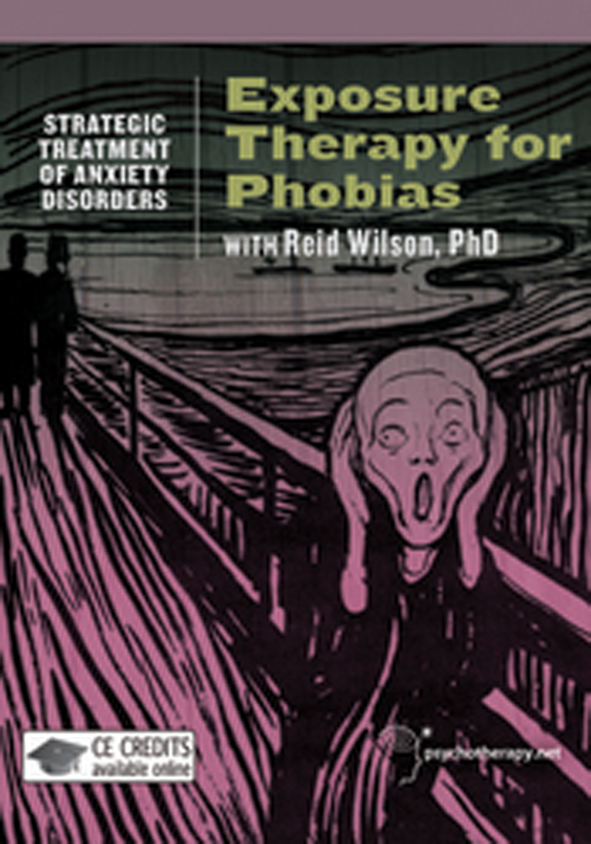Reid Wilson, Ph.D. is a licensed psychologist who directs the Anxiety Disorders Treatment Center in Chapel Hill and Durham, North Carolina. He is also Clinical Associate Professor of Psychiatry at the University of North Carolina School of Medicine.
Dr. Wilson specializes in the treatment of anxiety disorders. He is the author of Don't Panic: Taking Control of Anxiety Attacks (Harper Perennial), now in its third edition, co-author of Stop Obsessing! How to Overcome Your Obsessions and Compulsions (Bantam) and co-author of Achieving Comfortable Flight, a self-help kit for the fearful flier. He designed and served as lead psychologist for American Airlines' first national program for the fearful flier.
Dr. Wilson served on the Board of Directors of the Anxiety Disorders Association of America for twelve years. He served as Program Chair of the National Conferences on Anxiety Disorders from 1988-1991.
The whole DVD is conceived as a dialogue between Victor Yalom and Reid Wilson. The interviewer is Victor Yalom, Ph.D, CEO and founder of psychotherapy.net, an online psychotherapy magazine targeted to therapists and practitioners of all psychotherapeutic approaches.
Reid Wilson’s approach to treating anxiety disorders draws upon cognitive behavior therapy techniques to create a brief, aggressive, paradoxical treatment for people who suffer from anxiety disorders. Research has shown that exposure therapy is by far the most effective way to get lifelong results in the treatment of specific phobias.
Not many therapists had a chance to see live therapy sessions with real clients nor to access a good training specific for phobia. In the help of those trainee therapists eager to have rapid and long-lasting results with their clients comes the video in which Reid Wilson is giving step-by-step specific instruction to both trainee-therapists and client.
Reid conducts two sessions with a real client, Mary, who experiences different phases and facets of claustrophobia: the fear of using elevators (especially crowded ones), the fear of traveling in tunnels without being able to see the light at the end as humorously Dr. Wilson noticed, the fear of parking in tight and dark parking structures and most of all, the fear of flying, which is the most invalidating for Dr. Wilson’s client.
The goal of therapy, which is from the beginning disclosed by the therapist, Dr. Wilson, is to teach Mary simple techniques that she can use in the most fearful situations, in order to leave her with a sense of self-efficacy, so that when time comes she can be her own agent of change.
It is extraordinary to see how only in two sessions Mary was able to get up in a plane and to minimize consciously her fear, using the techniques taught by Dr. Wilson in the office. It helped a lot the fact that the client followed the prescriptions ‘religiously’, herself being trained as a teacher who understands the importance of logic and structure in the process of learning. Because above all, therapy is a learning process, a learning process about bodily functions, cognitive structures, mental processes and acknowledging with honesty what exactly works for each client, in the given moment.
One step closer, exposure therapy is not only about using a purely cognitive approach, but about exposing their clients to their worst fears, in the hope that they will learn skills that they will use in the real world when confronting those fears.
In the first session, before the actual treatment began, it was impressing to see how Dr. Wilson makes a thorough, structured, detailed assessment of Mary’s moments of experiencing the fears. He asks when the first activating event has occurred, what happened differently that day, what were the cognitions behind the anxieties, an approach that may seem didactic at first sight and perhaps a bit unexciting, but which helps tremendously to put order in the client’s mind. Wilson explains accurately what the process of habituation is, in the hope that the client will understand the importance of practicing in the office before practicing outside, in the real world. The use of props is also realistically used and continuously checked with the client, from the cocktail straws to the mask and scarf. Scaling is done regularly, regardless of the subjectivity involved. Each little step’s relevancy is checked with the client. At the end of first therapy session Mary is given a task, which is correctly executed.
More than that, in the second session of therapy, the client explains how she struggled to create an even worse situation than the real one, in the parking structure trying to close the window and putting her hands up as blinders. Not only the client insisted on creating a worse environment than the one he already perceived as frightening, but she also kept giving herself instructions meant to modify her way of thinking from “I won’t be able to do this” to “I will be able to handle this”. In the second session the focus was on preparing her for flying in a very rapid time-frame. Neuroscience is also used by explaining the way amygdala and emotional unconscious work in managing the fight and flight response to the actual threat.
The video is a vivid example on how you may teach effective therapy techniques to a client with claustrophobia, especially cognitive behavioral ones, in order to help her achieve important results in therapy and increase her quality of life. Dr. Wilson empowers the client to use the techniques he explained also outside the therapist’s office, offering Mary the wonderful opportunity to decrease the anti-anxiety medication to the point of complete cessation or extremely rare, occasional use.
The DVD is also a rich resource for trainee therapists who did not came across a phobia case in their practice and did not have the chance to use exposure therapy.
DVD $59.00 Individual Licence
DVD $89.00 Group Licence
More info at http://www.psychotherapy.net/video/Exposure-Therapy-Phobias
 This is an open access article distributed under the terms of the Creative Commons
Attribution License (
This is an open access article distributed under the terms of the Creative Commons
Attribution License (